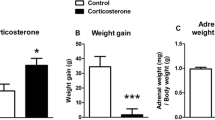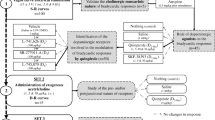Summary
Inhibition of catecholamine synthesis byα-methyl paratyrosine (α-MT) was previously shown to potentiate the behavioral suppression caused by dopamine-receptor antagonists. This effect ofα-MT is in all probability due to inhibition of the compensatory increase in dopamine turnover induced by the dopamine receptor antagonists. In the present study we investigated the effect of theα 2-adrenoreceptor agonist clonidine on the haloperidol-induced suppression of food-reinforced lever-pressing behavior (fixed ratio 40∶1) in rats. Small behaviorally inactive doses of clonidine were found, in analogy withα-MT, to enhance the haloperidol-induced suppression of the lever-pressing behavior. The haloperidol-induced increase in dopamine synthesis (measured as the accumulation of DOPA after inhibition of aromatic amino acid decarboxylare) was antagonized by clonidine in the striatum as well as in the dopamine rich limbic regions. Prazosin, a selectiveα 1-adrenoreceptor antagonist had no effect on the clonidine induced behavioral changes. Idazoxane, a selectiveα 2-adrenoreceptor antagonist, counteracted both the behavioral and biochemical effects of clonidine, indicating that these effects of clonidine are mediated via its action onα 2-adrenoreceptors. The present findings provide support for the notion thatα 2-adrenoreceptors may participate in the regulation of nigro-striatal as well as meso-limbic dopaminergic activity. It is suggested thatα 2-adrenoreceptor agents, especially in combination with classical antipsychotics, might be of therapeutic value in the treatment of disorders associated with abnormal dopaminergic activity.
Similar content being viewed by others
References
Ahlenius S, Engel J (1971 a) Behavioural effects of haloperidol after tyrosine hydroxylase inhibition. Eur J Pharmacol 15: 187–192
Ahlenius S, Engel J (1971 b) Effects of small doses of haloperidol on timing behavior. J Pharm Pharmacol 23: 301–302
Ahlenius S, Engel J (1973) On the interaction between pimozide andα- ethyltyrosine. J Pharm Pharmacol 25: 172–174
Ahlenius S, Engel J (1977) Potentiation byα-methyltyrosine of the suppression of food-reinforced lever-pressing behaviour induced by antipsychotic drugs. Acta Pharmacol Toxicol 40: 115–125
Anden N-E, Grabowska M (1976) Pharmacological evidence for a stimulaion of dopamine neurons by noradrenaline neurons in the brain. Eur J Pharmacol 39: 275–282
Anden N-E, Grabowska M, Strömbom U (1976) Different alpha-adreno-receptors in the central nervous system mediating biochemical and functional effects of clonidine. Naunyn-Schmiedebergs Arch Pharmacol 292: 43–52
Antelman SM, Caggiula AR (1977) Norepinephrine-dopamine interactions and behavior. Science 195: 646–653
Carlsson A (1975) Receptor-mediated control of dopamine metabolism. In: Usdin E, Bunney WE Jr (eds) Pre- and post-synaptic receptors. Marcel Dekker Inc, New York, pp 49–65
Carlsson A, Davis JN, Kehr W, Lindqvist M, Atack C (1972) Simultaneous measurement of tyrosine and tryptophan hydroxylase activities in brainin vivo using an inhibitor of the aromatic amino acid decarboxylase. Naunyn-Schmiedebergs Arch Pharmacol 275: 153–168
Carlsson A, Lindqvist M (1963) Effect of chlorpromazine or haloperidol on formation of 3-methoxytyramine and normetanephrine in mouse brain. Acta Pharmacol Toxicol 20: 140–144
Chapelo CB, Doxey JC, Meyers PL, Roach AG (1981) RX 781094, a new potent selective antagonist ofα 2-adrenoceptors. Br J Pharmacol 74: 842 P
Cohen DJ, Nathanson JA, Young JG, Schaywitz BA (1979) Clonidine in Tourette's syndrome. Lancet ii: 551–553
Dettmar PW, Lynn AG, Tulloch IF (1983) Neuropharmacological studies in rodents on the action of RX 781094, a newα 2-adrenoceptor antagonist. Neuropharmacology 22: 729–737
Doxey JC, Roach AG, Smith CFC (1983) Studies on RX 781094: A selective, potent and specific antagonist ofα 2-adrenoceptors. Br J Pharmacol 78: 489–505
Dwoskin LP, Sparber SB (1983) Comparison of yohimbine, mianserin, chlorpromazine and prazosin as antagonists of the suppressant effect of clonidine on operant behavior. J Pharmacol Exp Ther 226: 57–64
Engel JA, Johannessen K, Liljequist S, Goldstein M (1982) Enhancement of the haloperidol-induced suppression of food-reinforced lever-pressing behavior by interaction withα 2-adrenoreceptors. Soc Neurosci Abstr 8: 120
Felice LJ, Felice JD, Kissinger PT (1978) Determination of catecholamines in rat brain parts by reverse-phase ion-pair liquid chromatography. J Neurochem 31: 1461–1465
Freedman JE, Aghajanian GK (1984) Idazoxan (RX 781094) selectively antagonizesα 2-adrenoceptors on rat central neurons. Eur J Pharmacol 105: 265–272
Freedman R, Kirch D, Bell J, Adler LE, Pecevich M, Pachtman E, Denver P (1982) Clonidine treatment of schizophrenia: Double-blind comparison to placebo and neuroleptic drugs. Acta Psychiat Scand 65: 35–45
Fuxe K (1965) The distribution of monoamine terminals in the central nervous system. Acta Physiol Scand [Suppl] 247: 37–85
Goldstein M, Engel J, Lieberman A, Reger I, Bystrisky A, Mino S (1983) Therapeutic potentials of centrally acting dopamine andα 2-adrenoreceptor agonists. J Neural Transm [Suppl] 18: 257–263
Jouvent R, Lecrubier Y, Puech A, Simon P, Widlocker D (1980) Antimatic effect of clonidine. Am J Psychiatry 137: 1274–1276
Lindvall O, Björklund A (1974) The organization of the ascending catechol-amine neuron systems in the rat brain as revealed by the glyoxylic acid fluorescence method. Acta Physiol Scand [Suppl] 412: 1–48
Pycock CJ, Donaldsson IMG, Marsden CD (1975) Circling behaviour produced by unilateral lesions in the region of the locus coeruleus in rats. Brain Res 97: 317–329
Rabey JM, Passeltiner P, Bystritsky A, Engel J, Goldstein M (1981) The regulation of striatal DOPA synthesis byα 2-adrenoreceptors. Brain Res 230: 422–426
Starke K, Altman KP (1973) Inhibition of adrenergic neurotransmission by clonidine: An action on prejunctionalα-receptors. Neuropharmacology 12: 339–347
Svensson K (1986) Dopamine autoreceptor antagonists. A new class of central stimulants. Thesis. ISBN 91-7900-078-9. Kompendietryckeriet, Kållered
Trolin G (1975) Involvement ofα-adrenergic receptors at different levels of the central nervous system in the regulation of blood pressure and heart frequency. Acta Physiol Scand [Suppl] 430: 1–41
Author information
Authors and Affiliations
Rights and permissions
About this article
Cite this article
Engel, J.A., Johannessen, K., Liljequist, S. et al. Activation of α2-adrenoreceptors enhances haloperidol-induced suppression of operant behavior. J. Neural Transmission 66, 107–120 (1986). https://doi.org/10.1007/BF01260906
Received:
Revised:
Issue Date:
DOI: https://doi.org/10.1007/BF01260906




